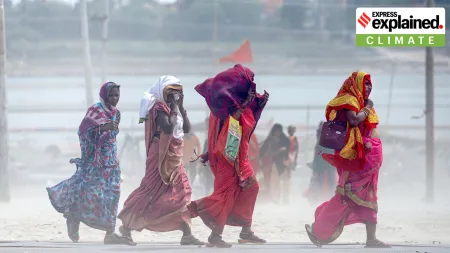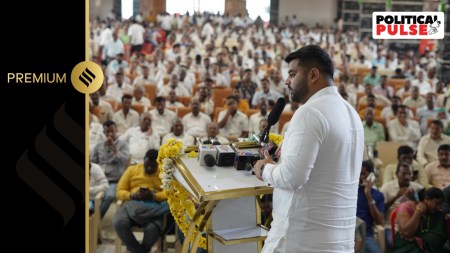- India
- International
In the outskirts of the Sundarbans, shrimp farms are turning to mangroves to go organic
In India, West Bengal is an important state when it comes to shrimp production, carried out in the hundreds of farms located across North and South 24 Parganas and the Purba Medinipur districts, an area that spans some 50,000 hectares.
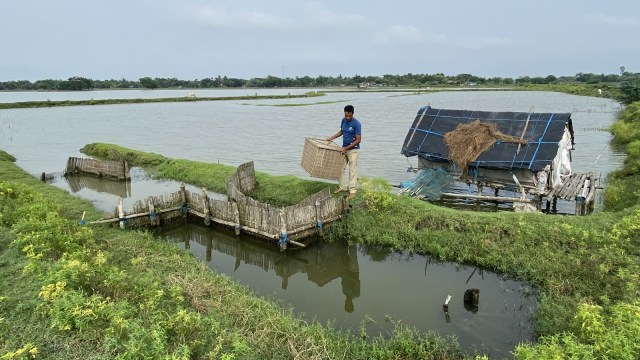 For over half a century, the Sundarbans biosphere has been a key region in the country for shrimp farming. (Express Photo by Neha Banka)
For over half a century, the Sundarbans biosphere has been a key region in the country for shrimp farming. (Express Photo by Neha Banka) On the outer fringes of the Sundarbans biosphere in West Bengal, Monirul Mondal is busy assessing the mangrove trees in front of him at various stages of growth. The mangroves of Haroa village serve a different purpose—here, the trees are actively nurtured and are used to cultivate organic shrimp in the massive farms spread in a handful of villages across the North 24 Parganas district.
It was a different scenario however a few decades ago, where the region witnessed large-scale clearing of mangrove forest land to accommodate the lucrative business of shrimp farming or aquaculture, which resulted in environmental degradation.
Shrimp aquaculture has been the primary occupation in Mondal’s household for generations, much like the other families living in Haroa and in the nearby villages in and around the Sundarbans biosphere. But the incorporation of mangrove trees in the aquaculture process as a transition towards sustainable practices has been a recent addition, one that is only a few years old.
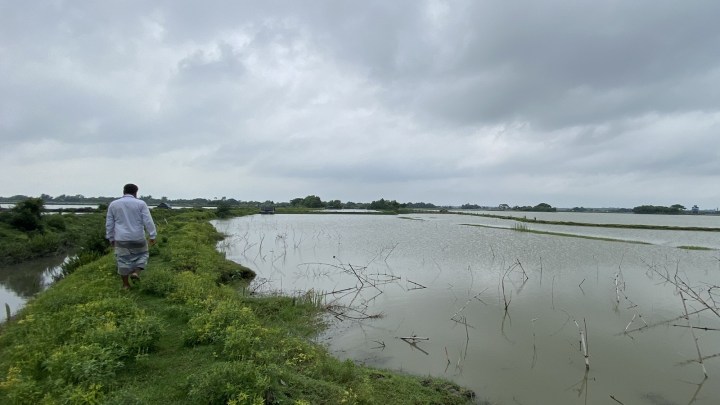 One of the many organic shrimp farms in Haroa, West Bengal. (Express Photo by Neha Banka)
One of the many organic shrimp farms in Haroa, West Bengal. (Express Photo by Neha Banka)
In India, West Bengal is an important state when it comes to shrimp production, carried out in the hundreds of farms located across North and South 24 Parganas and the Purba Medinipur districts, an area that spans some 50,000 hectares. According to the West Bengal state government data, in the country, the state ranks second in shrimp production after Andhra Pradesh. Globally, India is one of the top five shrimp-producing countries.
For over half a century, the Sundarbans biosphere has been a key region in the country for shrimp farming. But widespread shrimp aquaculture, particularly after the 1980s, to meet demands of markets in the west, has had a severe ecological impact on the Sundarbans biosphere, where unsustainable, unchecked farming practices directly resulted in mass-scale deforestation of the mangroves. “While the deforestation of mangroves had been happening for years, we saw even more deforestation for shrimp farming in the region,” says Dr. Bimal Kinkar Chand, joint director of research, West Bengal University of Animal & Fishery Science.

While shrimp aquaculture has been a highly profitable business, it has come under immense criticism globally for the disastrous impact that it has on the environment and water systems, particularly on mangrove loss, in several countries like Ecuador, India, Brazil, Panama, Thailand, Costa Rica and Indonesia. Marine shrimp farming as an aquaculture business is heavily dependent on brackish water, which is why the industry is so heavily concentrated in deltaic West Bengal.
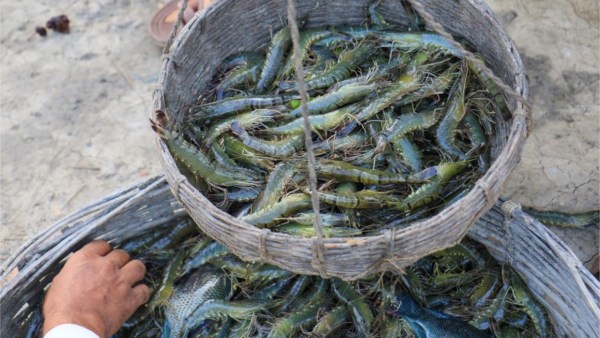 The black tiger shrimp Penaeus monodon from West Bengal forms the largest share of India’s seafood export contributions. (Photo credit: Dr. Sourabh Kumar Dubey)
The black tiger shrimp Penaeus monodon from West Bengal forms the largest share of India’s seafood export contributions. (Photo credit: Dr. Sourabh Kumar Dubey)
There is documented evidence that even before shrimp farming made a headway in the region, during the British colonial rule in the Indian subcontinent, particularly during the 1800s, the Sundarbans witnessed massive deforestation of the mangrove forest land, an area that had previously extended all the way up to what now forms the greater Kolkata metropolitan area. During that time, the clearing of the mangrove forests had been undertaken for agriculture and human settlement and conservation efforts did not begin in earnest till the 1970s.
Traditionally, depending on the season and salinity conditions, farmers in the coastal regions of West Bengal cultivated paddy in low-lying areas as the primary crop, along with small-scale fish and shrimp farming, in a method that was called the integrated paddy-fishery system, says Dr. Sourabh Kumar Dubey, a West Bengal-based researcher.
However, post the 1970s, the state witnessed a significant shift in the way shrimp was being farmed, where the method slowly began to involve the use of brackish water found in deltaic West Bengal in a shrimp-fish mixed farming system. The practice gained momentum in the 1980s, when the state and central governments made concerted efforts to develop coastal aquaculture and promote export-oriented shrimp farming, says Dr. Dubey.
Estuarine and coastal areas like the Sundarbans, are traditionally not agriculturally productive, Chand says. “When commercial fish farming started in India in 1988, aquaculture as a venture was highly profitable. Farmers and corporate entities became interested in investing in this and we saw large scale conversion of coastal areas for aquaculture use,” he says. The profits resulted in the conversion of not only agricultural land, but also waste land, into shrimp farms, along with the acquisition of artificial shrimp seed and feed manufacturing capability.
“When agricultural land and waste land got converted into shrimp ponds, it did have an environmental impact. When waste land was converted, if the peripheries had productivity, that peripheral land began seeing an increase in soil salinity. Agricultural productivity reduced gradually till it stopped, and farmers switched to shrimp aquaculture to reuse their land and earn money,” explains Chand.
The majority of industrial shrimp aquaculture occurs in the northeastern part of the Sundarban biosphere, says Anamitra Anurag Danda, the director of WWF India’s Sundarbans programme. Presently, shrimp-farming is concentrated in only six of the 19 sub-districts that form the biosphere and even within this, shrimp aquaculture is occurring on a large scale in the four sub-districts of Hingalganj, Sandeshkali, Haora and Minakha, as well as in adjoining blocks like Basirhat, which just skirt the edges of the biosphere.
On a smaller scale, shrimp aquaculture is occurring in one or two other districts in the region. “What makes the Sundarbans convenient for shrimp farmers is the lowlands, where it is easier to bring in brackish water during the tides, and there is no need to pump in water for farming requirements,” says Danda.
Sometime in 2012, Dubey began conducting research on whether the environmental impact of shrimp aquaculture in West Bengal could be reduced and whether mangroves and the shrimp production could coexist. In industrial shrimp farming, one of the criticisms has been against the excessive use of chemical pesticides and chemical feed for the shrimp which pollute the water system as well as the soil.
This method of shrimp aquaculture is called integrated mangrove aquaculture and has been in practice for some years now in countries like Indonesia, the Philippines, Thailand, Vietnam, Malaysia, Cambodia, and Myanmar in Southeast Asia, where mangroves are found, that also have shrimp aquaculture industries.
 Mangroves growing along the banks of the shrimp farms in Haroa, West Bengal. (Express Photo by Neha Banka)
Mangroves growing along the banks of the shrimp farms in Haroa, West Bengal. (Express Photo by Neha Banka)
But although India has a substantial mangrove forest in the Sundarbans, one of the largest of such biospheres in the world, representing 42% of India’s total mangrove vegetation, the practice was absent here.
“Our focus was mangrove conservation and how mangroves were good for shrimp farming. The leaves of the mangrove that fall in the shrimp pond are a part of the cycle where they generate nutrients. Nutrient cycling occurs when the leaves rot in the water, releasing nutrients that are beneficial to shrimp, and are in turn beneficial to the water systems as well as the profits earned by the farmer. Mangroves have a lot of biochemical compounds that reduce diseases of shrimp farming,” says Dubey.
Shrimp farming, while highly profitable, is extremely vulnerable to diseases that have the ability to decimate entire farms and Dubey’s research showed that integrated mangrove farming—the practice of organic shrimp farming using mangrove trees on banks of shrimp ponds, and allowing the trees and related microorganisms in the cycle do their job, mitigated the risks that came with the use of chemicals.
The model that is being used in the farms of Haora, involves a collection of ponds filled with shrimp where mangroves are grown along the embankments of the ponds, spread across a 20 km radius, in the Haora and Basirhat II blocks in the North 24 Parganas district in the state. Water exchange in these ponds are reliant on tidal flows that occur every 15 days, bringing in brackish water from the Bay of Bengal essential for growth of the shrimp. The ponds are equipped with a specifically designed inlet and outlet system that allow the flushing of debris and a catchment system used to collect the shrimp, processes that follow indigenous farming practices.
Presently, this is the only region where this method is being implemented, to understand whether it can be incorporated elsewhere where the state has large-scale shrimp farming.
In the farms of Haora, Mondal identifies the species of the mangroves using their local names in Bengali, that are growing along the banks of the aquaculture ponds: Sonneratia apetala or keora in Bengali, whose fruit is edible; Heritiera fomes that is better known as sundari, Bruguiera gymnorrhiza also known as kankra, etc.
What the farmers in Haora do has taken a lot of work, Mondal says, of the model designed by Dr. Dubey, a venture that is being implemented in association with Blue Sea Aquaculture, a Kolkata-based organic aquaculture production company. “In this area, we have about 15,000 people involved in aquaculture. Now, many are understanding the value of it because the production in these ponds is better than those who are not following the same method, but it has taken them time to realise that,” he says.
There are several challenges that the model faces, especially when it comes to convincing ordinary farmers who are simply looking for quick returns because of the pressing financial burdens they face. The integrated mangrove aquaculture yields lower shrimp production per unit area compared to intensive systems, which is one of the foremost concerns of the farmers.
But Dubey says that the long-term benefits make this valuable: this method requires less capital investment, making it more accessible to small-scale farmers. It also provides livelihood diversity through polyculture, allowing farmers to cultivate multiple species alongside shrimp that can be sold for consistent income. Most importantly, it is also climate resilient, and is less vulnerable to diseases, while simultaneously supporting biodiversity conservation through the preservation and regeneration of mangrove ecosystems.
“The integrated mangrove system can also work to aid climate change adaptation and mitigation. The mangrove conservation and restoration that happens in this process compensates mangrove loss that have occurred due to shrimp farming, and it also sequesters and stores blue carbon,” says Dubey.
Its benefits are also not limited to only one shrimp farm, but rather several in the area that are connected through the water network. “It acts as a biofilter for excess nutrient load and maintains water qualities of adjacent shrimp farms through nutrient exchange. The mangroves also work to strengthen dykes and help with protection from erosion control and other coastal hazards,” says Dubey.
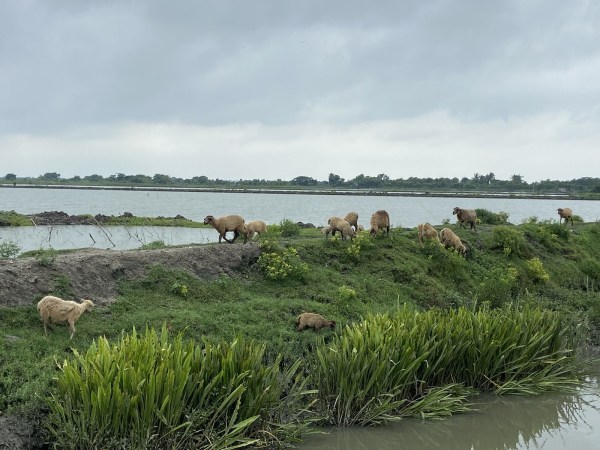 A loss of seeds and propagules of mangroves due to livestock grazing is a serious challenge that this method of aquaculture faces in Haroa. (Express Photo by Neha Banka)
A loss of seeds and propagules of mangroves due to livestock grazing is a serious challenge that this method of aquaculture faces in Haroa. (Express Photo by Neha Banka)
But the project has not come without its challenges. All of the mangrove saplings required for this project come from nurseries in the Sundarbans. One of the biggest difficulties that the team has faced is that of protecting the valuable mangroves, says Apurba Saha, director of Blue Sea Aquaculture. “No matter how much we protect these plants, we see villagers cutting them and walking off. The trees are cut for firewood because people don’t have an understanding of the role that the mangroves play here. But the advantage is that some farmers have been helping us with generating awareness,” says Saha.
“We also face difficulties with cows and goats that eat these plants. Sometimes, children, as well as adults, ruin the young saplings for fun. Although we tell them not to, they still come into the mangrove patches. Sometimes they come into the groves for the fruits of the mangroves. The matured plants are harder to destroy,” says Mondal. A loss of seeds and propagules of mangroves due to livestock grazing is a serious challenge that this method of aquaculture faces.
Presently, in Haroa, Dubey and his team have attempted to create temporary fencing using bamboo, but instances of livestock grazing and wandering villagers continue to occur.
“We just started this model in some parts in the outskirts of the Sundarbans, but it can be implemented on a larger scale,” says Dubey. He points to the coastal region of West Bengal, particularly in the Sundarbans, where he believes many brackish water ponds are currently underutilised. “These abandoned or low-productive ponds can be converted into mangrove areas, where it generates income for farmers living nearby, but in an environmentally friendly way,” says Dubey.
Buzzing Now
May 03: Latest News
- 01
- 02
- 03
- 04
- 05



